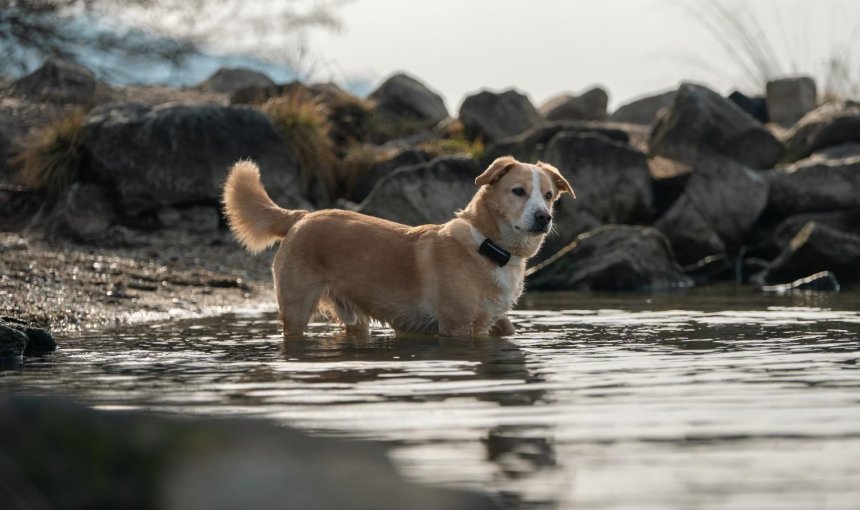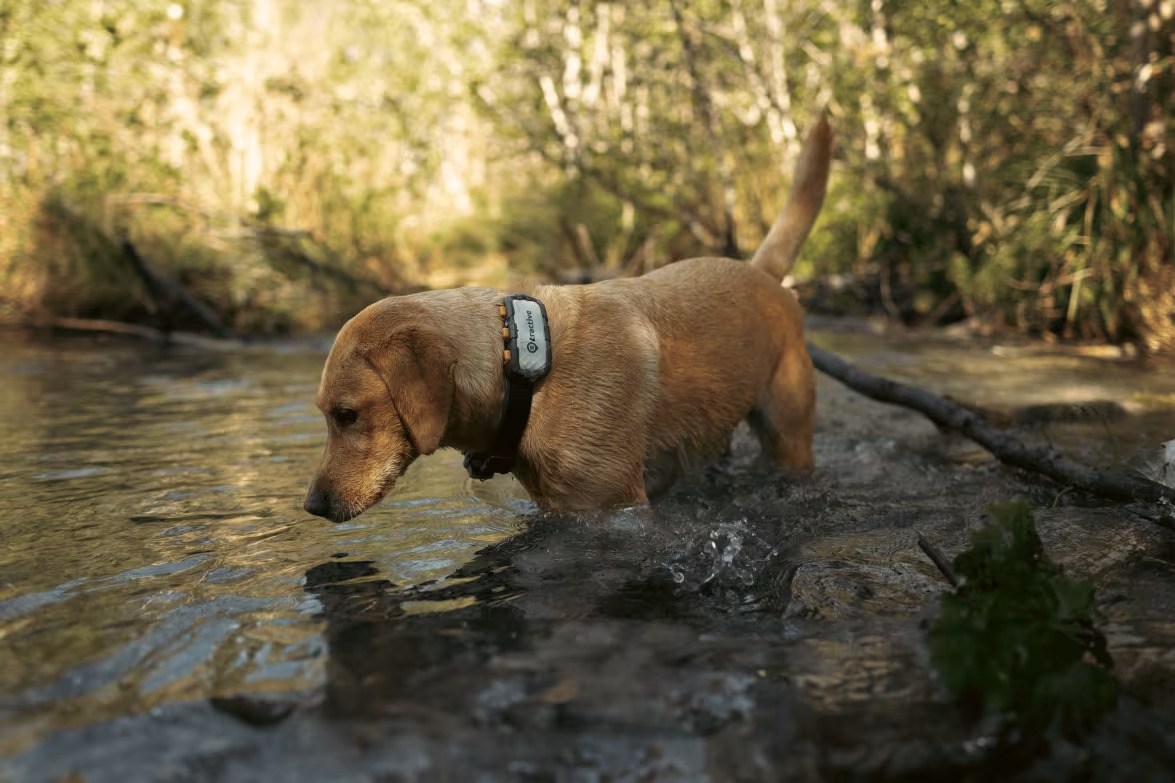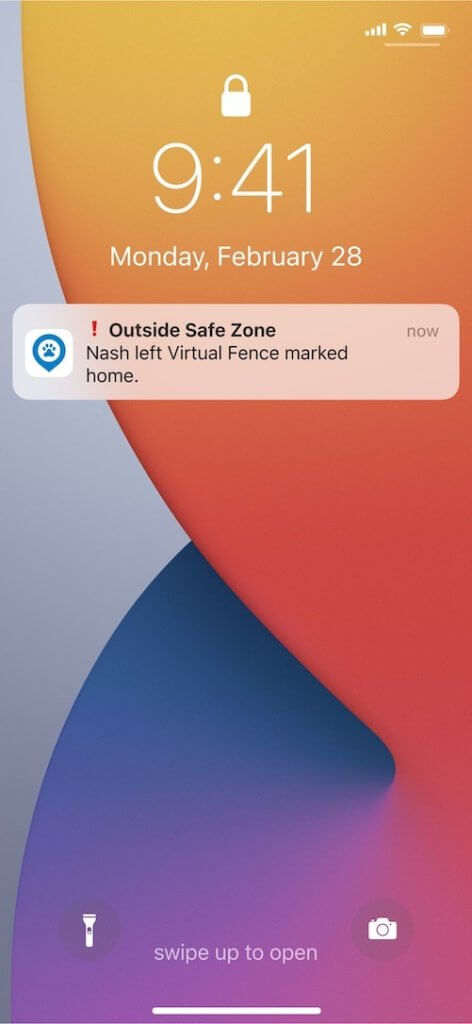Taking Your Dog Swimming? Your Ultimate Safety Guide
Want to take your dog swimming with you this summer? Here's everything you need to know about their first splash in ponds, lakes, rivers, oceans, and even backyard pools!

Despite having a swimming stroke named after them (the Doggy Paddle, of course) – turns out, not all dogs take to swimming like fish to water. Swimming with dogs can actually come with a couple of health risks if you’re both not careful! Here’s how you and your buddy can still enjoy a refreshing dip together – and the little piece of tech that’ll ensure you can track down an especially water-crazy dog in no time, in case they get lost.
Key Takeaways
Not all dogs are natural swimmers
A dog’s ability to swim depends on their breed, temperament, and physical anatomy. Brachycephalic (flat-faced) dogs or those with short legs and long bodies may struggle and require a life jacket.
Be aware of the risks
Swimming with dogs comes with potential dangers. These include ingesting too much water, exposure to harmful substances like chlorine or algae, and the risk of drowning.
Supervise and use safety gear
Never let your dog in the water unsupervised. Use a properly fitting life jacket for all dogs, regardless of their breed, and gradually introduce them to water.
Use a waterproof smart dog tracker as an emergency measure
Tractive devices are 100% waterproof and can help you track your dog in real-time, especially in situations where your dog might wander off. It also allows you to set up “safe zones” and “no go zones” in the app to get escape alerts.

Always know your buddy is healthy & safe
Read moreCan all dogs swim?
Technically, any dog can swim if they’re in good health and are properly introduced to swimming. How well they swim can depend on factors like:
- Their temperament
- How active they are – high-energy dog breeds might welcome a dip in the pool, even if they aren’t familiar with it!
- Their experiences, like if you’ve introduced them to swimming in a positive light when they were younger.
- Their breeding history, like specific dog breeds that were raised to hunt down other animals in water bodies.
- Their anatomy. Brachycephalic dogs, for example, might have difficulties breathing while swimming.
Dog breeds that might not do so well swimming
Some dog breeds don’t make great swimmers. For example, dogs with short legs and long bodies such as Basset hounds, Corgis, and Dachshunds may struggle to maneuver in deep water. Besides, dog breeds with big heads and flat faces like Pugs, French bulldogs, and Pekingese may have a hard time breathing while swimming, because they must tilt their head up to breathe. Bulldogs have a hard time swimming due to their body’s natural weight distribution.
💡But does that mean you can never take your dog swimming if they’re of a specific breed? Absolutely not. You’ll just need a little extra prep – like using a dog life vest or sticking to safe, shallow water bodies. (They’ll do just fine in a kiddie pool, for example.)
Dog breeds that like to swim
Golden retrievers and Labrador retrievers were bred to retrieve waterfowl for hunters, so they are typically comfortable entering bodies of water and swimming. Spanish water dogs, Portuguese water dogs, and American water spaniels, as their names imply, often have a natural affinity for water. In fact, some dogs like Newfoundlands, love water so much that they’re even trained as water rescue dogs! With their size and strength, Newfies can easily tug along heavy boats (and people) to the shore and safety.
💡A waterproof smart dog tracker with real-time GPS tracking can help you locate your water-loving dog in no time. (Especially if you worry they’ll run off to explore some beach or water body by themselves.)

Follow your dog anywhere
Get real-time location information, wherever they go. And find out when they try to make an escape, or just when they go somewhere they shouldn’t, with Virtual Fences.
Risks you might run into taking your dog swimming
Much like any other adventure outdoors, there’s always the chance you’ll run into some trouble taking your dog swimming along with you. Including:
- The chance they’ll ingest too much water, which can lead to diarrhea and vomiting
- Exposure to harmful substances you might find in swimming pools, like chlorine
- Exposure to bacteria, including from specific types of algae, which can make your buddy sick
- Drowning, especially if you aren’t around to intervene.
How to take a dog swimming – safely
Make your dog’s first experience in the water a positive one
On your first visit, wade in and see if your dog follows you. Ideally, start with a shallow body of water – like a kiddie pool – and in a familiar environment. Stay right by your buddy’s side and praise them plenty. It may take a few visits to the water before your pup is willing to plunge in. Just be patient and encouraging.
Try a plastic kiddie pool as a starting point
The hard plastic type of kiddie pool works best in this case. And not, say, an inflatable one which can be punctured by your dog’s toenails.
- Set the kiddie pool up in your backyard and add a few inches of water.
- Allow the water to warm in the sun for an hour or two.
- The kiddie pool’s slippery surface may not work for your dog, so lay some rubber mats on the pool’s floor for traction.
- Toss in some of your dog’s favorite toys.
- Hang out close by your furry friend and offer treats and praise each time they enter the water.
⚠️ Never start doggie swim lessons by throwing a ball into the ocean and having your dog chase it into the waves! They have no idea that the water gets deeper, or that a wave will suddenly knock them down. Your dog may panic and as a result could refuse to enter the water ever again.
Use a dog life jacket for safety
Make sure your dog has a properly fitting dog flotation device for each swim session. A dog life jacket will help your buddy feel confident in the water. Dogs with low body fat can benefit from a dog life jacket, because they may not stay afloat easily. Without a dog life jacket, these lean-bodied dogs have to work extra hard to keep their heads above water and could quickly become exhausted. (And drown as a result!)
Choose a dog life jacket made from waterproof materials and make sure it fits your dog properly. If you are boating with your dog, a life jacket with a handle allows you to lift your pup out of the water if they should fall overboard. Likewise, a life jacket with a D-ring is handy, allowing you to attach a leash while you walk on the beach with your dog.

⚠️ Don’t assume that because your dog is a breed that loves water, they will be safe without a life jacket! Any dog could still get into trouble if left alone, especially in the ocean. Meaning you should never allow your dog to swim without supervision.
Be extra careful if you want to swim together at the beach
The ocean is powerful and best enjoyed cautiously, especially if you are visiting with your dog for the first time. Start by walking the beach (with your dog leashed and wearing a dog life jacket). Take a few steps into the water, just up to your ankles, and see how your dog reacts. They may like it, or they may be afraid.
Keep the visit positive and don’t force your dog to go in the water. Never trick them by tossing a ball for them to chase into the ocean! Currents, riptides, and waves can overwhelm dogs just like they do to humans. Also, ingesting too much saltwater can cause problems ranging from mild diarrhea to death. So make sure to carry along plenty of fresh water for your buddy to drink when at the beach.
Watch out for freshwater bodies too
Lakes and ponds can be good choices for introducing your pup to the water. When entering a lake or pond from the shore, the water depth increases gradually, so your dog can go only as deep as they want to. While large lakes, such as the Great Lakes in the US, may have waves and strong currents, smaller lakes and ponds typically have little or no wave action. Always remember to put a dog life jacket on your furry friend for safety.
Likewise, watch out for blue-green algae that grow in ponds and lakes during hot summer weather. Also known as cyanobacteria, blue-green algae can cause a range of reactions including minor eye irritation, vomiting, diarrhea, lethargy, and even death. If the water looks discolored, smells bad, has lots of visible algae on the surface, or official warnings have been posted about blue-green algae, you and your dog should stay out of the water.
Be careful around swimming pools as well
Backyard swimming pools are generally considered safe places for dogs to swim under your supervision. When first entering a pool, you might want to carry your dog until they get comfortable, since most pools are too deep for a dog to stand in. Teach your pup where the pool’s exit points are so they can know in advance. A dog may not find the pool steps or ramp on their own.
But with all these perks, it’s important to recognize that there are some downsides of allowing your dog to swim in a pool. Dogs have a lot more hair than people do, and that hair will end up in your pool’s filtration system. Their fur ends up picking up debris like dirt, pollen, and even poop – all of which can contaminate the swimming pool. Likewise, dogs’ toenails can tear the pool liner or puncture inflatable pool toys. Finally, while a little bit of chlorine isn’t super harmful for dogs – too much chlorine can irritate your dog’s skin and eyes, especially if they swim often.
So if you decide to invite your pup into your swimming pool, brush and rinse them before the swim session. This will reduce the amount of debris that accompanies your pooch into the pool. Check your community pool to see if they offer dog swim days. Many seasonal community pools schedule a day for dogs to swim once the swimming pool closes to people at the end of summer.
How cold is too cold for dogs to swim?
Just like humans, dogs can get hypothermia from swimming for long periods in water that is too cold. Hypothermia occurs when the body loses heat faster than it can produce heat, resulting in a dangerously low body temperature. Experts say that a good benchmark is to add the air temperature and the water temperature readings. These two numbers should equal at least 100 degrees Fahrenheit to avoid cold water hypothermia. Another good rule of thumb: If its’ too cold for you to swim without a wet suit or dry suit, it’s too cold for your dog.
Read more: Dogs & Cold Weather: How Cold Is Too Cold For Dogs?
Where a waterproof smart dog tracker can help
A day of swimming with your dog is a fantastic way to bond and exercise. At the same time, it’s important to keep their safety in mind, especially in open water. This is where a waterproof smart dog tracker, like Tractive, can be your key to peace of mind. Designed for their splashiest adventures, Tractive trackers are 100% waterproof (IP68). Meaning they can handle being submerged in up to 1 meter of water for 30 minutes. Perfect for dogs who love to jump in and out of the lake, river, or even the ocean.

Strapped to your dog’s collar, this means you can now:
Monitor your dog’s every step – as they make their every step
Even the most well-behaved dog can get carried away by a scent or a current. Tractive’s real-time GPS tracking updates their LIVE location every 2-3 seconds. Meaning, you can see your dog’s exact location on a map on your smartphone. If they decide to chase a duck or explore a shoreline further down the beach, you can quickly find them and bring them back.
Besides, unlike an AirTag, Tractive devices don’t need a network of compatible devices to work. Meaning, they can help you find your dog over an unlimited range. (While connecting to cellular networks in over 175 countries.) Meaning, yes, you can track your dog even while on vacation.
Prevent your dog from running off too far
From your Tractive mobile app, you can use the Virtual Fence feature to set a safe perimeter on your phone. If your dog leaves this designated “safe zone” – like swimming out too far from the shore or wander toward a busy road – you’ll get an escape alert on your phone. So you now have a heads-up before your dog gets into a dangerous situation.






